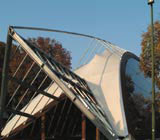Olympic ignition
Sara Manuelli visits Turin, which is revving up for the 2006 Winter Olympics with Atrium, created by car design guru Giorgietto Giugiaro

Turin is facing a major urban regeneration thanks to the impending Winter Olympics, scheduled for February 2006. Like many cities before it, this is a chance for Turin to change face.
It is doing so by bringing in creatives from around the world to create structures that will live long after the event, and transform this lesser-known Italian city into a cosmopolitan design destination. An investment of €465m (£322m) will be used to construct an array of Olympic and urban projects that include Turin’s first underground metro system, the revitalisation of the railway network and the construction of Olympic and media villages. The scheme also includes a new civic library and a grand avenue across the city, La Spina, which creates a central backbone for the new masterplan.
There is an international all-star line-up of design talent working on the attractions, including Jean Nouvel, who created the public square in the area Spina 1, Massimiliano Fuksas’ Piedmont region building, French group Arep Design’s Porta Susa railway station and the Olympic village by Turin architect Benedetto Camerana, who is coordinating the project and collaborating with Berlin designer Erick Weisner for the colour schemes. The village will be connected to the Lingotto (the ex-Fiat factory regenerated by Renzo Piano) via a futuristic arch-shaped footbridge, again by Camerana, Paris group Brit Hugh Dutton and Arup.
In anticipation of this impressive facelift, last week the city unveiled Atrium, in the Piazza Solferino. A temporary structure consisting of two arched pavilions constructed of wood and glass and created by Giugiaro Design, Atrium aims to be both physical space and symbolic location. The first, Atrium City, illustrates the many architectural projects that will take place via video and digital media installations. Atrium 2006 provides information about the sports facilities, events and athletes who will participate in the Olympics. The interior and exhibition design, by Turin group Archiland, reflects the moods and background to this transformation. The narrow space is cleverly exploited with alcoves, passageways and raised mezzanines, while water features, a sliced Fiat Cinquecento car and rubber tubes attempt to create an atmosphere out of a tight budget.
Atrium designer Giorgietto Giugiaro is no stranger to leaving a mark. Responsible for iconic car designs, from the original Volkswagen Golf, to the Lotus Esprit and the Maserati Bora, Turinese Giugiaro has risen over the years to become one of the most prolific industrial, transport and vehicle designers in Italy. Recently, his studio has diversified to include architecture – but it is yet to match the formidable reputation earned by its universally respected car design work.
However, for such an automobile-obsessed city as Turin, the home of Fiat, Giugiaro is both the local star and a perfect ambassador – something which made his appointment to design Atrium a political and necessary move. If Atrium fails to set the architectural world alight, it will at least succeed in promoting both the city and the event. As the countdown begins, you can’t go wrong visiting the pavilions as an appetiser for even better tastes to follow.
Atrium is in Piazza Solferino, Turin, Italy
-
Post a comment



